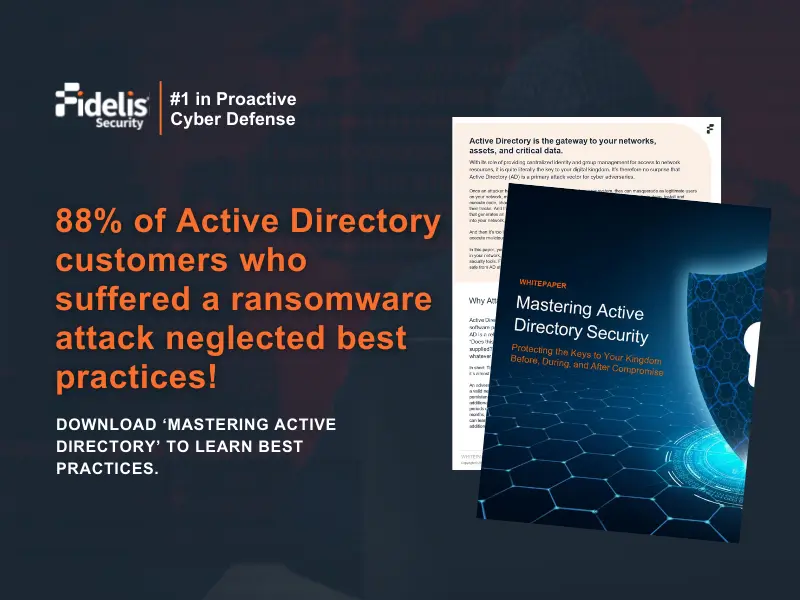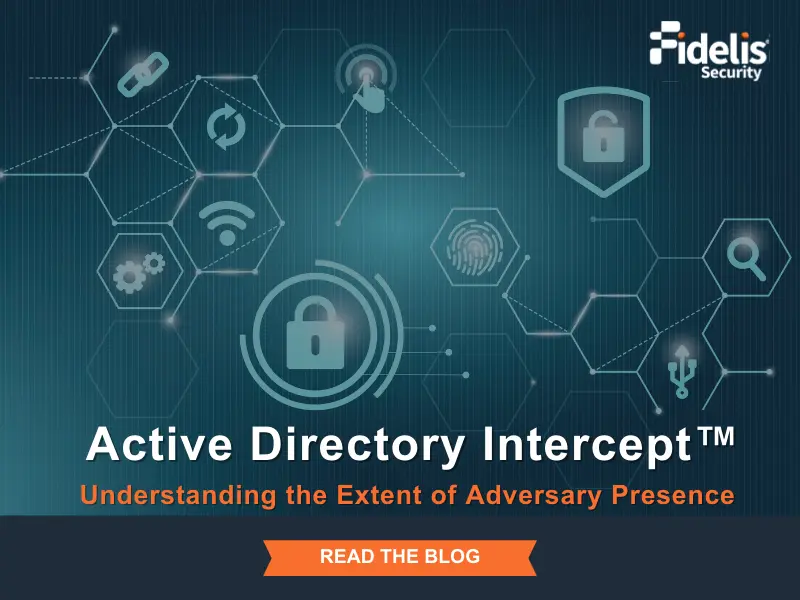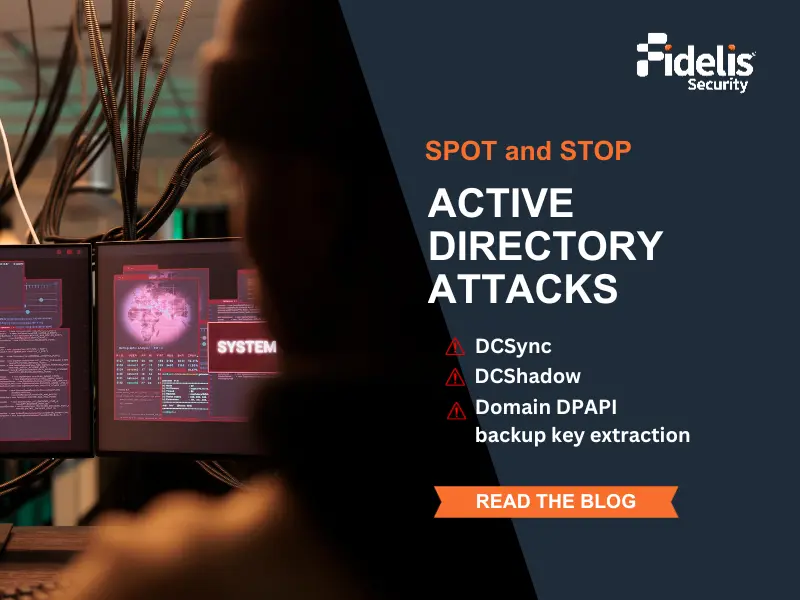95% of Fortune 1000 organizations use Active Directory (AD) to organize their IT systems. This statistic emphasizes the relevance of AD in modern enterprise networks. AD, as a centralized database including user accounts, group objects, workstation objects, security information, and much more, is critical for managing and securing IT resources. However, the very capabilities that make Active Directory so important, also make it an ideal target for cyber criminals.
In this blog, we’ll look at the top Active Directory threats that organizations should be aware of, as well as providing actionable insights on how to effectively mitigate these risks.
Active Directory Risks Assessment: Identifying Vulnerabilities
Before we get into the specifics, it’s important to understand the significance of doing extensive Active Directory risk assessment. This approach involves thoroughly assessing your AD environment to find any vulnerabilities and flaws that attackers could exploit.
By conducting a comprehensive risk assessment, you’ll better understand the Active Directory risks of your organization and can design a specific security strategy to address them. This approach is critical in today’s dynamic threat landscape, as cyber criminals are continually developing new ways to breach company networks.
8 Major Active Directory Threats to Watch Out For
Here’s a list of 8 important Active Directory threats businesses should be aware of and practical measures to mitigate them.
- Brute Force Attacks
- Lateral Movement and Privilege Escalation
- AD Ransomware
- Kerberos Attacks
- Domain Controller Compromise
- User Domain Threats
- DNS and DHCP Attacks
- Authentication Bypass
Let’s dive deep into each of these
Brute Force Attacks
Brute force attacks and password cracking are among the most common Active Directory threats. Attackers often use automated tools to crack passwords and exploit weak password policies, which allows them to get their hands on unauthorized access to sensitive data and systems within the network.
To stand strong against this threat, it is important to create strict password policies that require strong, complex passwords. This includes establishing minimum password length, use of special characters, and timely updating passwords. And, if you implement multi-factor authentication (MFA), it will act as an extra layer to the authentication process.
Password managers can also be an extremely helpful tool to protect you against password-based threats. By securely storing and generating strong, unique passwords for each user, password managers can help limit the risks of password breaches.
Lateral Movement and Privilege Escalation
Once the attackers get access to your network using brute force, they can use lateral movement techniques to spread throughout the domain and boost their privileges. This will give them access to sensitive network locations and then they can steal valuable data or disrupt critical systems.
To lower the risk of lateral movement and privilege escalation, you should install strong access controls and regularly monitor user behavior on the network. This includes assessing and upgrading user permissions regularly, implementing the principle of least privilege, and using tools like Fidelis’ XDR for detecting and responding to suspicious activities.
Active Directory Ransomware
Active Directory ransomware attacks have become a growing menace in recent years. These attacks encrypt vital files and data on the network, and in exchange for giving back the control and decryption key, the attackers demand money.
Well, to limit the impact of ransomware attacks, it’s quite necessary to maintain regular backups of your data and systems. This will ensure immediate restoration of your data in the case of a ransomware attack, and it sure will minimize the damage to business operations.
Furthermore, keeping your software and operating systems up to date is crucial, as many ransomware attacks use known vulnerabilities. By patching and updating your systems, you will dramatically lower the likelihood of a successful ransomware attack.
In addition to all that, you should consider investing in anti-ransomware tools and solutions, to provide an extra layer of protection.
Kerberos Attacks
Kerberos is a crucial authentication protocol used in Active Directory yet it’s not immune to attacks. Kerberos attacks, such as Kerberos replay attacks, have the potential to weaken the authentication process, which allows attackers to gain unauthorized network access.
Now the question arises, how to fight against it? Well, to prevent Kerberos attacks, you need to build secure Kerberos configurations and continuously monitor for any suspicious activity. This includes assessing and upgrading Kerberos settings regularly, as well as detecting and responding to potential attacks.
By staying vigilant and proactive in addressing Kerberos’ vulnerabilities you can reduce the chances of such attacks.
Domain Controller Compromise
Domain controllers are considered the heart of Active Directory. It handles the user accounts and access permissions. If your domain controller gets compromised, then attackers can easily get unrestricted access to the whole network.
To avoid domain controller compromise, you should deploy strong security measures such as safe boot configurations and regular monitoring for suspicious activities. By doing so, you can reduce the chances of a successful attack against your Active Directory.
User Domain Threats
While you might be focused on external threats, do not ignore insider threats and social engineering attempts. These types of attacks usually involve trusted users or staff members, making it more difficult to detect and mitigate.
To address such threats, again you must have strong access controls, actively monitor user activities, and regularly provide security awareness training to your employees. This helps to educate your employees on the newest social engineering techniques out there and gives them the ability to detect and report suspicious conduct.
DNS and DHCP Attacks
As you know, DNS and DHCP are important infrastructure components of Active Directory, and if they are immune to threats then it can interrupt network operations and open a backdoor for attackers.
To defend your system against these attacks, you need to implement secure configurations and monitor activities regularly. In addition to those you can deploy solutions such as Fidelis’ XDR platform that detects and quickly responds to potential threats safeguarding your Active Directory.
Authentication Bypass
These attacks make use of vulnerabilities in the authentication process to gain unauthorized access to the network. These types of attacks can be especially difficult to identify and fight against as they often bypass traditional security measures.
To defend against authentication bypass attacks, you should develop multi-factor authentication.
Conclusion: Safeguarding Your Active Directory
To summarize, the threats to Active Directory are numerous and constantly advancing. But if you understand these major threats and implement the security policies well, you can lower the likelihood of a successful attack while also protecting critical digital assets.
At Fidelis Security, we understand the critical role that Active Directory plays in enterprise networks. We’re committed to guiding organizations through the complexities of cybersecurity and protecting them from Active Directory threats. Whether you want to strengthen your defenses or stay ahead of emerging risks, we have you covered.
Concerned about the security of your Active Directory? Want to explore how Fidelis Security can help you? Please do not hesitate to contact us. We’re here to provide you with the knowledge and solutions you need to protect your user domain and manage the constantly changing threat landscape.



